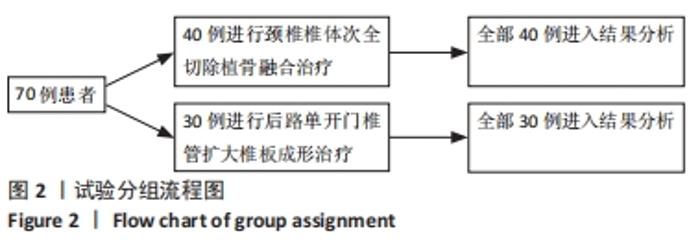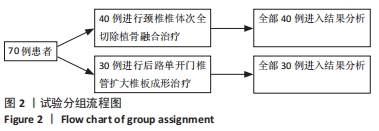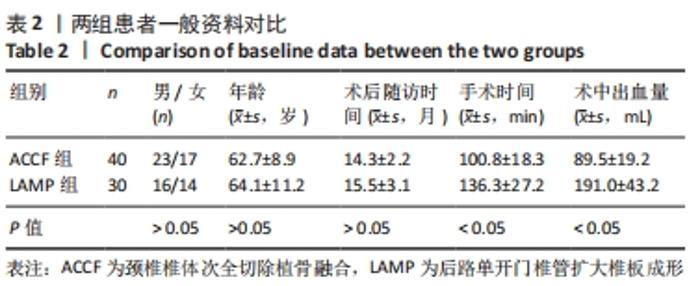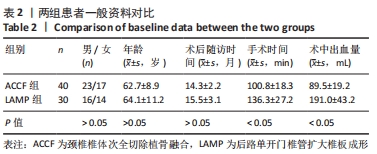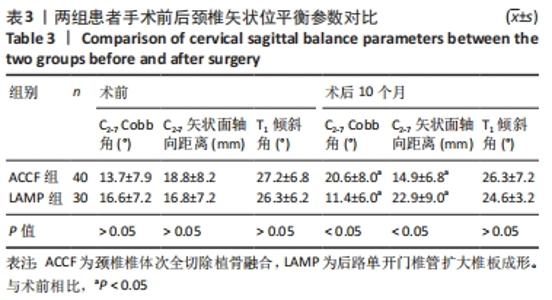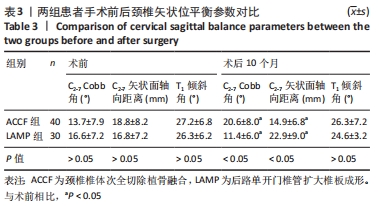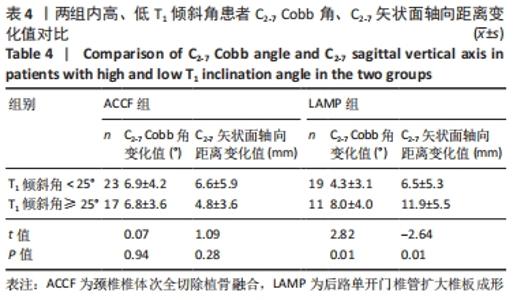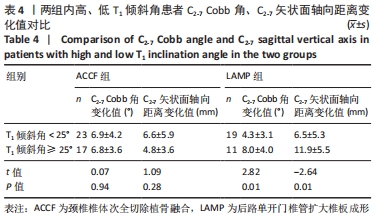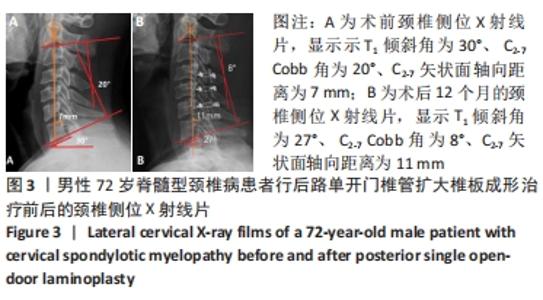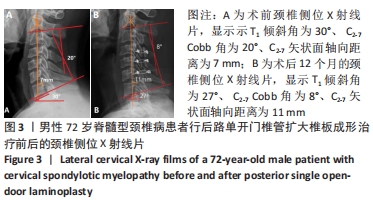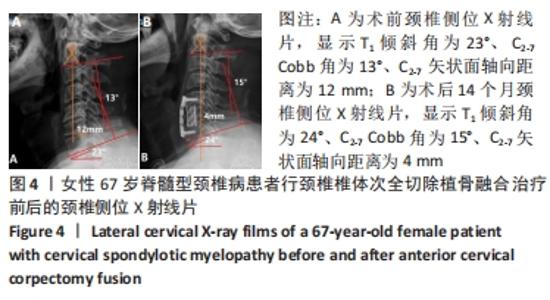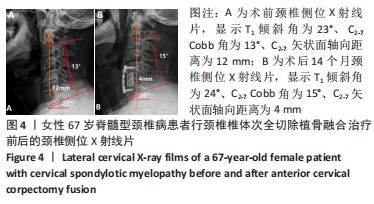[1] BAKHSHESHIAN J, MEHTA VA, LIU JC. Current Diagnosis and Management of Cervical Spondylotic Myelopathy. Global Spine J. 2017; 7(6):572-586.
[2] DAVIES BM, FRANCIS JJ, BUTLER MB, et al. Current surgical practice for multi-level degenerative cervical myelopathy: Findings from an international survey of spinal surgeons. J Clin Neurosci. 2021;87:84-88.
[3] MONTANO N, RICCIARDI L, OLIVI A. Comparison of Anterior Cervical Decompression and Fusion versus Laminoplasty in the Treatment of Multilevel Cervical Spondylotic Myelopathy: A Meta-Analysis of Clinical and Radiological Outcomes. WorldNeurosurg. 2019;130:530-536.e2.
[4] LI Z, CHEN L, LI B, et al. Efficacy and Safety of Surgical Interventions for Treating Multilevel Cervical Spondylotic Myelopathy via Anterior Approach: A Network Meta-Analysis. Pain Physician. 2019;22(4): E275-275E286.
[5] AKBAR M, ALMANSOUR H, DIEBO B, et al. Normal sagittal profile of the cervical spine - must the cervical spine always be lordotic? Orthopade. 2018;47(6):460-466.
[6] 刘法敬,丁晓坤,胡成栋,等.颈后路单开门术中椎板不同固定方法对颈椎曲度及轴性症状的影响[J].中国综合临床,2019(4):322-326.
[7] SON DK, SON DW, SONG GS, et al. Effectiveness of the laminoplasty in the elderly patients with cervical spondylotic myelopathy. Korean J Spine. 2014;11(2):39-44.
[8] 余文超,袁文,陈华江,等.脊髓型颈椎病颈前路手术对术后颈椎矢状位平衡参数的影响[J].中华骨科杂志,2018,38(21):1285-1292.
[9] JIANG SD, JIANG LS, DAI LY. Anterior cervical discectomy and fusion versus anterior cervical corpectomy and fusion for multilevel cervical spondylosis: a systematic review. Arch Orthop Trauma Surg. 2012; 132(2):155-161.
[10] 邓元,倪斌.颈椎矢状序列测量方法的研究进展[J].中国脊柱脊髓杂志,2014,24(7):655-659.
[11] HUANG K, CHANG BQ, YU CJ, et al. Anterior corpectomy combined with intervertebral decompression and fusion for multilevel cervical spondylotic myelopathy. Zhongguo Gu Shang. 2018;31(1):18-22.
[12] LIU X, MIN S, ZHANG H, et al. Anterior corpectomy versus posterior laminoplasty for multilevel cervical myelopathy: a systematic review and meta-analysis. Eur Spine J. 2014;23(2):362-372.
[13] HARTMANN S, TSCHUGG A, OBERNAUER J, et al. Cervical corpectomies: results of a survey and review of the literature on diagnosis, indications, and surgical technique. Acta Neurochir (Wien). 2016;158(10):1859-1867.
[14] KATO M, NAMIKAWA T, MATSUMURA A, et al. Effect of Cervical Sagittal Balance on Laminoplasty in Patients With Cervical Myelopathy. Global Spine J. 2017;7(2):154-161.
[15] LIN T, WANG Z, CHEN G, et al. Is Cervical Sagittal Balance Related to the Progression of Patients with Cervical Spondylotic Myelopathy? World Neurosurg. 2020;137:e52-52e67.
[16] LING FP, CHEVILLOTTE T, LEGLISE A, et al. Which parameters are relevant in sagittal balance analysis of the cervical spine? A literature review. Eur Spine J. 2018;27(Suppl 1):8-15.
[17] MCAVINEY J, SCHULZ D, BOCK R, et al. Determining the relationship between cervical lordosis and neck complaints. J Manipulative Physiol Ther. 2005;28(3):187-193.
[18] ROGUSKI M, BENZEL EC, CURRAN JN, et al. Postoperative cervical sagittal imbalance negatively affects outcomes after surgery for cervical spondylotic myelopathy. Spine (Phila Pa 1976). 2014;39(25):2070-2077.
[19] SAKAI K, YOSHII T, HIRAI T, et al. Impact of the surgical treatment for degenerative cervical myelopathy on the preoperative cervical sagittal balance: a review of prospective comparative cohort between anterior decompression with fusion and laminoplasty. Eur Spine J. 2017;26(1):104-112.
[20] OE S, YAMATO Y, TOGAWA D, et al. Preoperative T1 Slope More Than 40° as a Risk Factor of Correction Loss in Patients With Adult Spinal Deformity. Spine (Phila Pa 1976). 2016;41(19):E1168-1168E1176.
[21] HYUN SJ, KIM KJ, JAHNG TA, et al. Relationship Between T1 Slope and Cervical Alignment Following Multilevel Posterior Cervical Fusion Surgery: Impact of T1 Slope Minus Cervical Lordosis. Spine (Phila Pa 1976). 2016;41(7):E396-402.
[22] PATWARDHAN AG, KHAYATZADEH S, HAVEY RM, et al. Cervical sagittal balance: a biomechanical perspective can help clinical practice. Eur Spine J. 2018;27(Suppl 1):25-38.
[23] 曹鹏,顾一飞,周文超,等.椎体次全切除术与椎管扩大椎板成形术术后颈椎矢状位平衡的对比研究[J].脊柱外科杂志,2017,15(6): 331-334.
|
